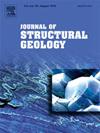瓦里斯坎比利牛斯山脉等斜褶皱中的变形和磁性结构
IF 2.9
2区 地球科学
Q2 GEOSCIENCES, MULTIDISCIPLINARY
引用次数: 0
摘要
磁性结构被用作应变标记,因为它们反映了岩石中颗粒的方向分布。本文从磁化率各向异性(低温和室温)的角度分析了比利牛斯山轴向带泥盆系(29个点)和奥陶系-志留系(3个点)沉积岩的611个样品。主要目标是确定与灰岩和页岩中的Variscan(多相)和Alpine造山运动有关的应变。磁信息还来源于热磁曲线、等温剩磁(IRM)和剩磁矫顽力分析,以及磁滞回线和诱导剩磁在三轴上的逐步热退磁。磁特性分析辅以光学显微镜观察和钙量测定。在两个样品区(Sen和Llisat山谷),磁化率椭球的最小轴(kmin轴)大多垂直于层理,而在另外两个样品区(Zinqueta山谷和Posets峰附近地区),发现了一个更发达的构造:kmin轴不完全垂直于层理,磁化率椭球与片理面有关。不同矿物具有磁黄铁矿、磁铁矿(铁磁性)和层状硅酸盐(顺磁性)等一致的磁性结构,方解石颗粒(反磁性)的影响很小。磁性结构被解释为在瓦里斯坎变形的早期阶段形成,在与花岗岩侵位同步的右旋变形之前形成,这是瓦里斯坎造山运动晚期的特征。然而,接触变质作用和伴随的流体循环可以增强或消除原始磁性结构。本文章由计算机程序翻译,如有差异,请以英文原文为准。
Deformation and magnetic fabrics in isoclinal folds of the Variscan Pyrenees
Magnetic fabrics are used as strain markers since they reflect the orientation-distribution of grains in a rock. In this work we analyzed, from the point of view of anisotropy of magnetic susceptibility (at low-temperature and room temperature), Devonian (29 sites) and Ordovician-Silurian (3 sites) sedimentary rocks in the Pyrenean Axial Zone, totalling 611 samples. The main target is to determine the strain in relation to the Variscan (polyphased) and Alpine orogenies in limestones and shales. The magnetic information also derives from thermomagnetic curves, acquisition of the isothermal remanent magnetization (IRM) and coercivity of the remanence analyses, together with hysteresis loops and stepwise thermal demagnetization of induced IRM in 3 axes techniques. The analyses of magnetic properties were complemented with optical microscopy observations and calcimetries. In two of the sample areas (Sen and Llisat valleys), the minimum axes of the magnetic susceptibility ellipsoid (kmin axes) are mostly perpendicular to bedding whereas in the other two (Zinqueta valley and near Posets peak area), a more developed tectonic fabric is found: the kmin axes are not completely perpendicular to bedding, and the magnetic susceptibility ellipsoid relates to the foliation plane. Different minerals carry a concordant magnetic fabric with pyrrhotite, magnetite (ferromagnetic s.l.) and phyllosilicates (paramagnetic), and little influence of calcite grains (diamagnetic). The magnetic fabric is interpreted to form at the early stages of the Variscan deformation, prior to the dextral transpression synchronous with granite emplacement that characterizes the late stages of the Variscan Orogeny. However, contact metamorphism and associated fluid circulation can enhance or obliterate the primary magnetic fabric.
求助全文
通过发布文献求助,成功后即可免费获取论文全文。
去求助
来源期刊

Journal of Structural Geology
地学-地球科学综合
CiteScore
6.00
自引率
19.40%
发文量
192
审稿时长
15.7 weeks
期刊介绍:
The Journal of Structural Geology publishes process-oriented investigations about structural geology using appropriate combinations of analog and digital field data, seismic reflection data, satellite-derived data, geometric analysis, kinematic analysis, laboratory experiments, computer visualizations, and analogue or numerical modelling on all scales. Contributions are encouraged to draw perspectives from rheology, rock mechanics, geophysics,metamorphism, sedimentology, petroleum geology, economic geology, geodynamics, planetary geology, tectonics and neotectonics to provide a more powerful understanding of deformation processes and systems. Given the visual nature of the discipline, supplementary materials that portray the data and analysis in 3-D or quasi 3-D manners, including the use of videos, and/or graphical abstracts can significantly strengthen the impact of contributions.
 求助内容:
求助内容: 应助结果提醒方式:
应助结果提醒方式:


